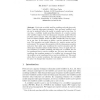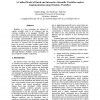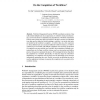BPM
2003
Springer
14 years 3 months ago
2003
Springer
A top-down approach for workflow design is proposed in the framework of Petri net theory. Simple but powerful refinement rules are proposed that guarantee soundness of the resultin...
APN
2003
Springer
14 years 3 months ago
2003
Springer
Abstract. Petri nets are widely used for modeling and analyzing workflows. Using the token-game semantics, Petri net-based workflow models can be analyzed before the model is actua...
GCC
2006
Springer
14 years 3 months ago
2006
Springer
Increasingly scientists are using collections of software tools in their research. These tools are typically used in concert, often necessitating laborious and error prone manual ...
GCC
2006
Springer
14 years 3 months ago
2006
Springer
In this paper we present Amadeus, which is a holistic service-oriented environment for QoS-aware Grid workflows. Amadeus considers user's requirements, in terms of QoS constr...
ESCIENCE
2006
IEEE
14 years 3 months ago
2006
IEEE
Workflow is a key technology for eScience. It enables scientific tools to be composed and the resulting workflows to be managed. Workflow and most other computing tools typically ...
ESCIENCE
2006
IEEE
14 years 3 months ago
2006
IEEE
In this paper we present a general domain for the analysis of workflows and workflow components based on the notion of a collection of Turing machines sharing a set of tapes. We s...
DILS
2006
Springer
14 years 3 months ago
2006
Springer
Steps in scientific workflows often generate collections of results, causing the data flowing through workflows to become increasingly nested. Because conventional workflow compone...
DILS
2006
Springer
14 years 3 months ago
2006
Springer
Abstract. Workflows are gaining importance as a means for modelling and enacting in silico scientific experiments. A major issue which arises when aggregating a collection of analy...
DEXA
2006
Springer
14 years 3 months ago
2006
Springer
Abstract. Workflow Management Systems (WFMS) coordinate execution of logically related multiple tasks in an organization. A workflow schema is defined using a set of tasks that are...
DEEC
2006
IEEE
14 years 3 months ago
2006
IEEE
Abstract. Engineering workflow applications are becoming more and more complex, involving numerous interacting business objects within considerable processes. Analysing the interac...



